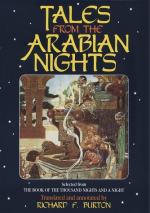When the man in the cage had ended his story, the magnanimous Hatim bade him be of good cheer, for he would at once endeavour to relieve him. By the aid of the fairies, who carry him through the air for the space of seven days, he arrives in the desert where the Flowers of Light shine brilliant as lamps on a festival night, diffusing the sweetest perfume far and wide; and recking naught for the serpents, scorpions, and beasts of prey which infested the place (for he had a talisman that protected him), he advances and plucks three of the largest and most brilliant flowers. Returning in the same manner as he had gone thither, he reaches the spot where the blind man Hamir is imprisoned; taking down the cage, he releases the wretched man, compresses the stalk of the flower so that the juice drops upon his sightless eyeballs, and when this has been repeated three times Hamir opens his eyes, and seeing Hatim falls prostrate at his feet with a profusion of thanks.
Although there are some differences in the details of the story of Baba Abdullah and that of Hamir, as above, yet the general similarity between them is sufficient to warrant the conclusion that if one was not adapted from the other, both must have been derived from the same source; and here we have, I think, clear evidence of the genuineness of another of the tales which Galland was believed to have invented himself.
History of Sidi Nu’man—p. 187.
It is curious to find this current as a folk-tale at Palena, in the Abruzzi, without any material variation except in the conclusion. My friend, Mr. E. Sidney Hartland, has favoured me with the following abstract of the Italian version, as given in vol. iii. of the “Archivio per lo studio delle Tradizioni Popolari” (Palermo, 1882), p. 222:
There was once a husband and wife. The wife says that she cannot eat anything, and only picks a few grains of rice with a large pin. Her husband asks why she eats nothing, and she answers that she does not want to eat. Meantime she goes out secretly every night, and the husband begins to have suspicions of her. One night he follows her softly and finds she goes to the burial ground, where she meets with certain female companions. They open a grave and feed on the flesh of the dead. The next morning the husband cooks rice again, and the wife picks up a few grains of it with a pin as before. The husband exclaims, “What! you enjoy the flesh of dead




